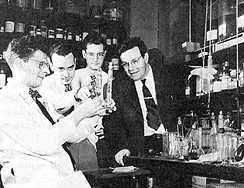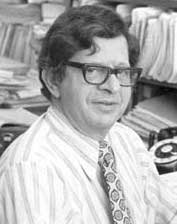Isolation and
identification of element #61 was finally made by (shown
from left to right) Jacob A. Marinsky (1918-),
Lawrence Elgin Glendenin (8.11.1918-) and
Harold G. Richter working with Charles
Dubois Coryell (21.2.1912-7.1.1971)
separating fission fragments during World War-II.
They precipitated Cerium from the rare earth fraction
as an iodate, Yttrium, Samarium, and Europium by
digestion with carbonate, then separated the rest using
an Amberlite ion exchange column. Praseodymium,
Neodymium, element #61, and Yttrium were adsorbed at
different levels and eluted with ammonium citrate at
various pHs. Element #61 emitted beta rays with a 3.7-year
half life. 14761 was confirmed by mass
spectrograph. The most stable isotope currently known
has a half-life of 25 years, too short to be in any of
the minerals investigated in the 1920s. Grace
Mary Coryell suggested the name Prometheum
(Pm = #61): Prometheus was the god
who stole fire from heaven. He gave it to humans and
was daily punished by Zeus. Since Promethium does not
exist except in fission products, it was named for the
courage and pain needed to synthesize new elements. In
1949 the International Union of Chemistry adopted the
spelling Promethium. |
 |
| zleva: Jacob (Jack) A. Marinsky, Lawrence E. Glendenin, Harold G. Richter a Charles Dubois Coryell |

